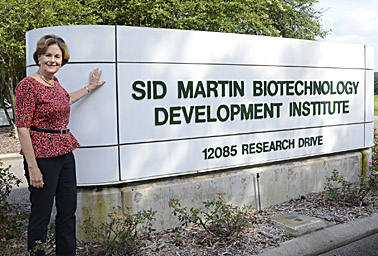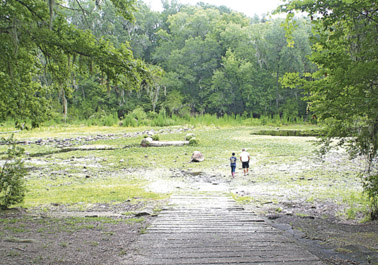 Patti Breedlove directs the Sid Martin Incubator in Progress Corporate Park. She was made director this year while the incubator continues to gain international recognition.
Patti Breedlove directs the Sid Martin Incubator in Progress Corporate Park. She was made director this year while the incubator continues to gain international recognition.
ALACHUA - When Patti Breedlove started working at the Sid Martin Biotech Incubator in 1998 as a program coordinator, her first task was to throw a party for the first two companies who were "graduating" out of the incubator from startup companies to self-sufficient businesses. A lot has changed since then.
Breedlove, 65, is now the director of the Sid Martin Biotech Incubator in Progress Corporate Park in the city of Alachua. She is responsible for executing the overall vision of the incubator, which is to help small, fledgling companies in the biotechnology field grow. It provides these companies with space, equipment, mentoring and whatever else they might need, Breedlove said.
"She's not just a landlord, that's for sure," said Jackson Streeter, CEO of Banyan Biomarkers, a resident biotech firm at the incubator.
"She's extremely proactive," he said. Breedlove helps the companies recruit people to fill positions, arranges facility tours and spends time to get an understanding of what issues the businesses face and how she can help.
"She has a big network that she can reach out to," Streeter said, noting how she has helped Banyan search for investors.
Her schedule for a typical week might include making phone calls to try and improve the scientific equipment in the incubator, having lunch with real estate agents to help the biotech companies find land for facilities, meeting with representatives from marketing firms and giving tours to the Gainesville Chamber of Commerce.
Part of her job is forming a strategic vision for the incubator, but another part is being its external face and being an advocate, Breedlove said.
"Patti is such an outgoing, positive advocate of life sciences in the region," said Sue Washer, CEO of graduate company AGTC, which researches cures for rare lung and eye diseases.
As the face of the Sid Martin Biotech Incubator, Breedlove, who was only made the director this year, has recently seen some recognition for the success of her facility. It was ranked as the world's best biotech incubator by the Sweden-based research group, UBI.
"For a long time, we had no recognition," Breedlove said. "We're thrilled. It's really put a spotlight on our program."
UBI found Breedlove's incubator creates 2.8 times more jobs than the global average, and that despite the fact that European incubators provide nine times as much funding, they create 1.9 times fewer jobs.
Even though she has done well with less funding than incubators in Europe, getting seed funding is still sometimes an issue for Breedlove, as well as finding more space for the facility.
Setting a good culture, hiring the right people and giving them the freedom to do their jobs has been key to do more with the funding they have, Breedlove said. She runs the incubator like a business, rather than have it function like a massive university.
Things are a lot different in Alachua than when Breedlove started.
"I've seen a lot of changes since I started here in 1998," she said. "This area has really grown up in terms of technology. There's a real high energy in Alachua County in trying to grow new biotech companies."
Breedlove said she hopes to continue to see the area develop like it has over the past 15 years.
# # #
Email cmckinney@
alachuatoday.com
Add a comment

